Menus
- 2 cylinders in line, 1200 cc, 77 hp at 6100 rpm, 106 Nm at 4000 rpm, 237.5 kilos dry, from ¤ 14 350
- More muscle, more techno, more dark for the Bobber
- Discovery
- In the saddle
- Engine and transmission
- In the city
- On motorways and main roads
- On departmental
- Part-cycle
- Brakes
- Comfort and duo
- Consumption & autonomy
- Conclusion
- The video test of the Triumph Bonneville Bobber Black
2 cylinders in line, 1200 cc, 77 hp at 6100 rpm, 106 Nm at 4000 rpm, 237.5 kilos dry, from ¤ 14 350
More muscle, more techno, more dark for the Bobber
"Is that SpongeBob’s motorcycle?" Asks a child of the family to whom I explain that I am going to work in the south of Spain to try a Bobber. ! Well not at all, little scarab. Historically, the bobber genre has its roots at the end of WWII when returning GI’s get a little bored and are looking for adrenaline trying to make better performing motorcycles. For this, they remove everything that is useless: we end up with a new type of motorcycle, which is characterized by a small handlebars, a small tank, more mudguards, a rigid rear frame (it started based on Harley) and relative care in the finish of the whole. The "bobber" genre was born and Triumph, with its 500 Speed Twin from 1937, also played its part in this movement, which gives the brand of Hinckley (ex-Meriden for those who know) a great legitimacy for it. to come back.
It is also on the new platform of the 1200 Bonneville that Triumph launched, at the beginning of 2017, a Bobber version, suddenly stripped down. With this model, Triumph was advancing steadily by having had 200 pre-orders when dealers in the network first returned on this model. Ten months later, Triumph France is close to 700 sales with this model and the success is proportionately identical in many countries, which makes Triumph admit that this is their fastest sale in 115 years of history, to the point that they had to rearrange production to increase the rate.
In fact, let’s admire the responsiveness of the British brand which, in order not to miss a nice ride on this wave of success, is already launching a new version: the Bonneville Bobber Black.
Is it just a stroke of paint? No, it’s more subtle than that. We explain to you.
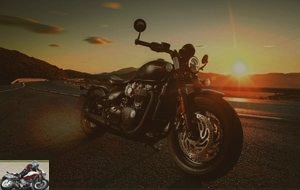
Discovery
We were used to seeing extravagant motorcycles coming out of specialist workshops like Wrench Monkees or Blitz Motorcycles, but the uppercut is all the stronger since it is a factory machine. It is true that it really stands out from the mass of standardized and anonymous machines, this Bobber. Low, long, stripped down, it appeals as much in static as in action with this saddle which seems suspended and all this rear part which moves together under the effect of the suspension. A success, especially as the level of finish and the sense of detail are of very high level, as evidenced by the badges, the battery cover, the dummy carburetor tanks which hide the injection system. Great art.
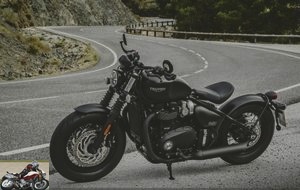
A Bonneville Bobber Black (I suggest that from now on, for convenience, it’s called BBB) isn’t just a Bonneville Bobber painted in Henry Ford’s favorite color. Already because two versions of black are on the program for the bodywork: glossy or matt black (the latter requiring an additional effort of ¤125). Of course, all the trim is also black, the housings, the levers, the footrests, the exhausts, the mirrors, the headlight casing. All. Another novelty on the BBB: the appearance of LEDs on the headlight, since the indicators and the taillight use the same technology..
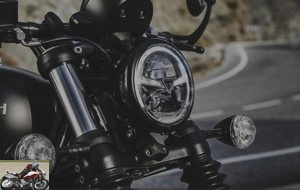
But it’s not just a BBB. It’s also more techno and more muscle with a redesigned front end, which abandons the 19-inch wheel for a 16-inch wheel. More details below.
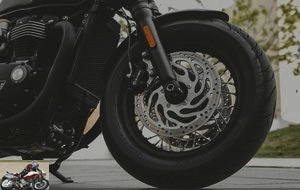
In the saddle
Perched at only 690 mm, the saddle is accessible to all, especially as the footrests in the middle position and the normally flat handlebars do not impose a gibbon physique to feel good on board, unlike other low machines. saddle, but with radical ergonomics. Here, you immediately feel at ease, especially as the tank of only 9.1 liters of capacity makes it easy to hold the machine with your knees..
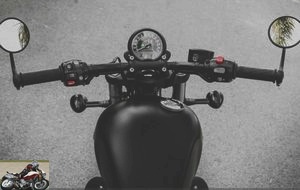
Located at the end of the handlebars, the mirrors are easily adjusted and allow you to have a nice rear view. Once on board, it is necessary to take the reflex to find the place where to put the ignition key (on the right side of the machine, behind the leg). The dashboard looks simple: a big speedometer and a digital window, but this one has a lot of information that one would not expect at first glance on a machine with minimalist vocation. Thus, there are two trips, the average and instantaneous consumption, the hour, the gear indicator engaged, the range, a fuel gauge, as well as the engine speed. All this is easily displayed by pressing the "info" button on the right control unit. This same button allows to activate or not the traction control. For their part, the two engine maps (rain or road) are managed on the right commodo. The icing on the cake: the dashboard is tiltable via a hinge. Very cool.
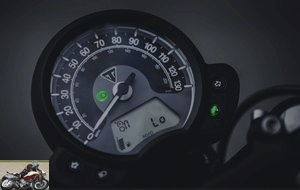
Engine and transmission
No modifications here between the Bonneville Bobber and our BBB: it is the "HT" (High Torque) version of the last generation 1200, an 8 valve block, water cooled and set at 270 ° and which develops 77 horsepower а 6100 rpm and 106 Nm of torque at 4000 rpm. But compared to a Bonneville T120, you should know that the Bobber engine and therefore our BBB has 10% more torque at low revs, which gives it a character more in line with its deceptively cool personality..
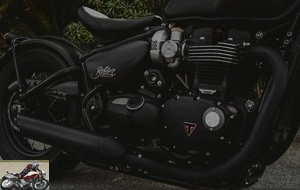
On the "rain" mapping, the power remains at 77 horsepower, it is the way in which it is delivered which is softer. That said, we did not have the feeling that it was day and night compared to the "road" mode..
The gearbox is 6-speed and the secondary transmission by chain. New on the BBB: a speed regulator is introduced, which can be activated from 3rd gear. The ergonomics of this regulator is simple: one press to activate it, one second to engage it at the speed of the moment, a third to deactivate it knowing that it only takes a single stroke of the brake to put it on standby.
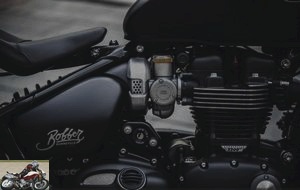
In the city
We drove in Marbella by 18 ° C in mid-December, which is better than curdling our loaves on a ring road saturated by a Climate Summit which generates a lot of pollution (go figure, Charles!)! In short, what we could see is that the turning radius is very correct, that the 16-inch wheel and its large front tire do not engage at all and are remarkably neutral, even in roundabouts where you do not have the handlebars which suddenly "fall" as can be experienced on machines with similar geometry.
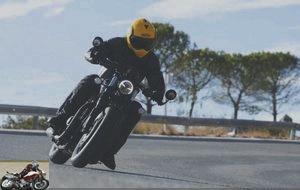
Soft control, progressive brakes, everything is fine, especially since the engine has a nice extension: at 50 km / h, it is 2000 rpm in third and the speed regulator can allow you not to be flashed on the boulevards.
What we have not been able to test, on the other hand, is the machine’s ability to interface in Parisian conditions, knowing that the mirrors are at the end of the handlebars. Nevertheless, the BBB remains compact and the handlebars are only 760 mm wide, so it should pass … On the other hand, the lock, we put it around the neck: if you take a design model, it can be pretty.
On motorways and main roads
No problem for the big twin: it purrs at 3400 rpm to 130 km / h in sixth and everything is fine. The bike being compact and the driving position not too "flag", we cash the purge of the motorway without suffering too much from the wind, even if Triumph has other things in the catalog (like Tiger 1200 XRt vintage 2018) if that’s really your thing. It is obvious that by its driving position and its small tank, the BBB like all bobbers will flourish in another biotope. Notwithstanding, the motor extends well, the mechanical vibrations are contained, the stability does not call for criticism. It is much less painful than the handlebars of a Harley 48, for example.
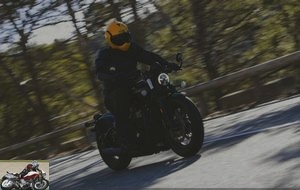
Otherwise, the cruise control operates up to 160 km / h. For the brave.
On departmental
At 2350 rev / min in 6th for 90 km / h, the big 1200 does not force to keep pace on the secondary network. By definition, the BBB has more fun in reasonable paces, if only because it allows more people to be able to unhook their jaws in front of its sculptural plastic..
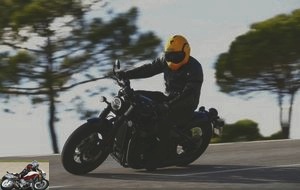
At a reasonable pace, which will most certainly be adopted by 95% of its owners, the BBB can be handled with great ease. The frame is sound and turns completely, the weight of about 250 kilos with the full tank is not too much felt, even if there is a little inertia when putting it on the angle. Nothing to worry about.
However, compared to the Bonneville Bobber, the BBB differs in its front end. The first big evolution is the change from a 100/90 x 19 tire to a 130/90 x 16 tire, guided, no longer by a KYB fork of 41 mm in diameter, but by a solid Showa of 47 mm. Apart from a very small stiffness at the change of angle (which is easily combated, with the narrow rear tire, identical to that of the Bonneville Bobber) and the rather low center of gravity, we have nothing but praise for this new front end, because it remains absolutely neutral and frank in its reactions.
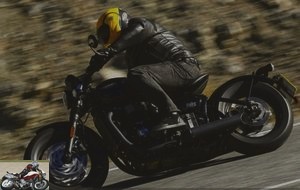
On the brakes side, the single 310mm disc with its two-piston NIssin caliper was among the criticisms voiced on the older model. With the 310 mm Brembo twin disc, still pinched by 2-piston calipers, the bite is more present and the power more pronounced. An evolution that goes in the right direction, therefore.
Suddenly, one can try to adopt a small "hurry, but careful" rhythm with the BBB and it generates a little pleasure, if only because the machine is healthy, despite the structural limits of which it is not. responsible. Obviously, the ground clearance ends up showing its limits, it is normal. Obviously, we will take a little margin in the attack, because when we are on the crutch, it is always more complicated to tighten a trajectory. But the machine is sound, turns in a block, reacts equally depending on whether you lead it to the handlebars or to the footrests and you have fun with it. The motor delivers a very correct torque, afterwards, we must admit that we do not have the arms which lengthen either, because in this definition HT, the 1200 shows a certain inertia to go in the revs, say au- above 4000 rpm, but it still extends the stride well with a second gear that climbs to 120 km / h and a third above 150 km / h. On the other hand, when you start to ride sport, you must not make a mistake when entering a corner and favor the engine brake to help the motorcycle to turn, because you are still on a heavy machine with large pistons..
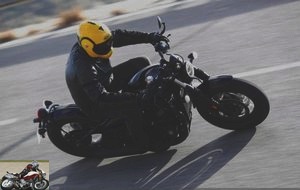
Part-cycle
New front end: this is what sets this BBB apart and we have already talked about it. The Showa fork debates on 90 mm and the rear shock on 77 mm, which is little more so as it is not adjustable, but Triumph explains that the absence of passenger allows to better calibrate the suspensions. In fact, it is correct and we appreciate a certain rigor in the road feel. Afterwards, the low deflections can not work miracles either and on the big breaks, the suspensions send a few strokes of the racket. But in this area, the BBB remains clearly superior to its (American) competitors of the bobber genre..

We have already praised the neutrality of the front end. The narrow rear tire (150/80 x 16) adds great agility.
Brakes
Criticized on the first version, the dual front device is much more convincing. Power, bite, progressiveness, it’s all there. At the rear, Triumph has retained on the BBB the 255mm disc clamped by a 2-piston Nissin caliper already seen on the BB. What good, then? No, alas: ABS is really sensitive. Even in the dry, it is impossible to brake hard from the rear without releasing it continuously, while a sudden grip from the front allows it to be released, in a straight line, in the dry. You must therefore learn to adjust your braking.
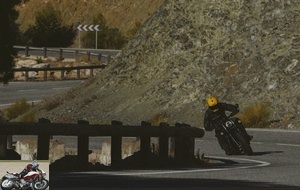
Comfort and duo
A little firm, this comfort. The saddle holds well and its ergonomics are not a problem, but its coating turns out to be a little firm in use. Nothing serious, but when I write a little firm it’s as opposed to I can’t say it’s chewy. Ditto for the suspensions, which we console ourselves by praising the rigor of the road feel. Anyway, the typical clientele of this machine does not seem predisposed to align bollards and then even then the 9.1 liter tank will impose salutary breaks..
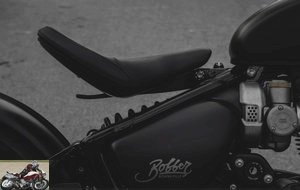
And what if you meet a Geraldine, who falls in pвmoison in front of your posture, this relaxation affirmed and sublimated by this low machine and full of muscles? Well it’s simple: you take her contact on Tinder and you manage afterwards like the big boy (or girl) that you are (or you send her to the nearest Triumph dealer so that she can buy one too).
Consumption & autonomy
On this test, quite winding and therefore making a lot of use of the gearbox, this 1200 BBB gave us an average consumption of 5.2 l / 100. With the 9.1 liters of the tank, that makes a range of 175 kilometers, which is nothing exceptional. Triumph claims a theoretical range of 226 kilometers. It is not quite that. At the same time, can we recognize that this machine spends most of its life showing off on the boulevards rather than exploring the depths of the Morvan? ?
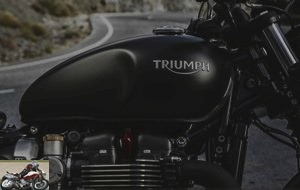
Conclusion
The BB was good, the BBB is even better: more stylish, more techno, more muscular. All this is due to the fact: its front axle is neutral, it brakes better, it has more electronics (LED lights, cruise control). With the additional posture provided by the dark key, this is well worth an extra of at least ¤ 1000 and 8 kilos (mainly on the new front axle). Given the success of the first version of the Bobber, the answer seems ready.
However, dear reader, I have bad news for you: you have just typed 11 paragraphs so complete that Le Repaire could resell them to Wikipedia for a lot of money. Nevertheless, bravo, first, but alas, it is useless. Because the Bobber genre does not suffer from existential analysis. A Bobber is a crush, a flash, a desire, an emotion. It doesn’t really matter the power, the technical sheet, the objective qualities. In fact, who cares. And so, even the price, which puts the Triumph in the upper echelons, at the level of the Indian, while the Harley is significantly less expensive, but also significantly less sophisticated..
Which gives the BBB two comparative advantages: one, for those who swear by the looks, it’s simple, the BBB, she rocks her mother, the BB. Two, rational people wanting to emancipate themselves can still set their sights on this Triumph. Considering that its competition is only represented by the Harley-Davidson Sportster 48 and the Indian Scout Bobber, the answer is simple. The Triumph is much less limited in its use than the Indian; it is also much more powerful, more techno and more reassuring than the Harley, which is here figure of prehistoric machine. Full box, therefore !
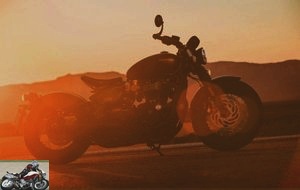
Strong points
- Amazing look in static
- Incredible posture in dynamics
- Nice, flexible, torquey engine
- Pleasant twin sound
- Complete electronics (speed regulator, traction control …)
- Complete dashboard, on-board computer…
- Ergonomic controls
- More efficient braking
- Healthy chassis
Weak points
- Limited autonomy
- Limited ground clearance, necessarily
- Comfort a firm hair
- Very sensitive abs
- Premium rate
- Poor grip of Avon tires (especially in the wet, but do these machines run in the wet, that is ze question!)
The technical sheet of the Triumph Bonneville Bobber Black
Test conditions
- Route: 160 km, mostly mountain roads, in the pretty Marbella and Ronda area (Spain)
- Motorcycle mileage: 800 km
- Problem encountered: none
Competition: Harley-Davidson Sportster 48, Indian Scout Bobber
The video test of the Triumph Bonneville Bobber Black
Related articles
-
Triumph Bonneville Speedmaster test
In-line twin, 1200 cc, 77 hp at 6100 rpm, 106 Nm at 4000 rpm, 245.5 kilos dry, from € 14,350 A more modern proposition in the 1200 cruiser segment… Are…
-
Triumph Bonneville Bobber test
Rebel Bonnie Commercial success and historical reference of a market that smacks of the motorcyclist belle epoque , the Triumph Bonneville are expanding…
-
To put in all hands !! Yes, I know, I am a little too biased to write this essay considering my visceral attachment to the English brand, but I will do…
-
Queen of Hearts Twin of 1200 cm3, 105 hp, 112 Nm, Brembo M50 calipers, Metzeler Racetec RR tires, 16,700 euros A historic sporting legend led by equally…
-
A reputation acquired on the speed tracks Ode to sport and motorcycling history Celebrity from across the Channel, the Triumph Thruxton is finally…
-
Pure roadster The English brand has already presented its many Modern Classic novelties to us with a now large and complete Bonneville family. The update…
-
Character legend Completely redesigned but faithful to its legend and its aesthetic codes, the Bonneville reinvents itself with talent and efficiency in…
-
Triumph Speed Triple 1200 RS motorcycle test
Madame More 3 cylinders in line, 1160 cm3, 180 hp at 10,750 rpm, 125 Nm at 9,000 rpm, 198 kg in running order, from € 17,500 Each time a new product is…
-
Triumph Speed Triple R 1050 motorcycle test
A top-class Speed Triple From the luxury spokes from Ohlins for the suspensions, Brembo for the monobloc calipers and PVM for the forged wheels, the…
-
Gentleman Badass Triumph reinvents its flagship model, the Bonneville, in two versions, 900 Street Twin and T120 cubing 1200 cm3, succeeding the T100….
It would only have taken a 3 liter tank, if it was only to park it in front of the cafe around the corner….
A V-Strom 650 is more homogeneous and can be fitted with a suitcase + top case;)
And you found the right shock absorber …?
During a test, I just found it unbearable, even almost nonexistent, on a little bumpy road.
When I explained my surprise to the guy who sells them behind his counter, he told me that in fact it was better to immediately put a good amorto (a little 1000 bill?) To correct that (sic).
The adaptable luggage 3 pieces + the supports, are (there still count 1500 balls of +) … but we guess that if Yam does not foresee it himself, it is perhaps that in terms of solidity-security (back loop) it’s limit, nah ?
In short, in my opinion 2 "small" annoying details for a "small" GT …
Do not confuse a "GT" type Tracer 700 model from a roadster, and a road trail type Vstrom 650 which is a full-fledged model (for example different frame, specific cartography etc …) and which is, him, intended for travel and could be called Vstrom 650 GTL without usurping its name!
+1 on the various comments. After having just used a V-Strom 650 then a Versys 650 on solo trips, the Tracer 700 GT did not convince me, especially for the duo this time. For lack of finding better, the replacement will perhaps be a V-Strom again, I just would have liked to find a model with a little more engine compartment (while remaining in average displacement which I appreciate for ease of life) …
If Yamaha does not recommend suitcases + topcase, there are solutions however at Shad or Kappa (images added in the article) and it seems that some dealers also mount Yamaha at all and that this does not deteriorate the behavior of the machine according to his owner ! Thanks to Vincentgetorix from the Tracer700 group for the photo.
[attachment 32358 actu.jpg]
I find the Yam range very coherent: the MT with the front which lifts by itself for young urban children, the Tenere as a real trail for adventurers, the Tracer for those in their thirties who do quieter roadtrips but with a few small strokes of madness. The old people, either they are hooked to their liner of 250 kg for 30 years, or they go down in displacement to 500 or even 125.
No huge changes with this Euro 5 Tracer, but you don’t change a winning team.
Even the Tracer 900 allows you to go below 5L / 100 without dragging yourself.
So the 700 should go under the 4L5.
The drinks announced by Yam on his motorcycles have become realistic and perfectly achievable by the common biker.
Purchase excluded due to the height of
Saddle.